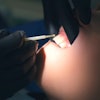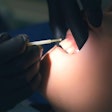The number of erupted primary molars and canines may be linked to how often parents reported awake bruxism (AB) in young children, according to a study recently published in the Journal of Oral Rehabilitation.
During this stage of tooth development, teeth grinding while awake may be adaptive behavior, the authors wrote.
“Clinicians should monitor primary dentition development closely and recognise AB as a potentially adaptive behaviour,” wrote the authors, led by Letícia Fernanda Moreira-Santos of the Federal University of Minas in Brazil (J Oral Rehabil, June 4, 2025).
This cross-sectional study took place in southern Brazil between September 2021 and April 2022. It included 144 children ages 4 to 36 months who had not yet developed a full set of primary teeth. Researchers collected data during routine dental clinic visits using a 14-question interview, they wrote.
The questionnaire covered oral habits such as pacifier use, nail-biting, and signs of tooth eruption like irritability and increased salivation. Parents or caregivers also reported the frequency of parent-reported awake bruxism (PRAB) using a standardized diagnostic method.
The mean number of erupted primary molars, canines, and incisors was four (±3.0), 2.4 (±1.9), and 6.3 (±3.0), respectively. PRAB was observed in 16.7% of children. Children with PRAB once or twice per week had significantly more erupted molars (median = eight, range = four to eight) than those with bruxism three or more times per week (median = 2.7; range = two to seven) (p = 0.004), they wrote.
Additionally, a similar pattern was observed with canines, with higher numbers in the lower-frequency group (median = four; range = four to four) compared to the higher-frequency group (median = two; range = zero to four) (p = 0.007).
However, the study had limitations. Mandibular bracing and thrusting were difficult to assess due to early observation challenges, highlighting the need for age-appropriate methods, the authors added.
“The number of erupted primary molars and canines was associated with the frequency of PRAB in early childhood, supporting the hypothesis that AB during this stage may represent an adaptive behaviour,” they concluded.




















